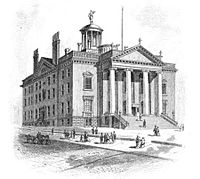44th New York State Legislature
| 44th New York State Legislature | |||||
|---|---|---|---|---|---|
|
|||||

The Old State Capitol (1879)
|
|||||
| Overview | |||||
| Jurisdiction | New York, United States | ||||
| Term | July 1, 1820 – June 30, 1821 | ||||
| Senate | |||||
| Members | 32 | ||||
| President | Lt. Gov. John Tayler (Clint.) | ||||
| Party control | Bucktail (19-13) | ||||
| Assembly | |||||
| Members | 126 | ||||
| Speaker | Peter Sharpe (Buckt.) | ||||
| Party control | Bucktail | ||||
| Sessions | |||||
|
|||||
| 1st | November 7 – 20, 1820 |
|---|---|
| 2nd | January 9 – April 3, 1821 |
The 44th New York State Legislature, consisting of the New York State Senate and the New York State Assembly, met from November 7, 1820, to April 3, 1821, during the fourth year of DeWitt Clinton's governorship, in Albany.
Under the provisions of the New York Constitution of 1777, amended by the Constitutional Convention of 1801, 32 Senators were elected on general tickets in the four senatorial districts for four-year terms. They were divided into four classes, and every year eight Senate seats came up for election. Assemblymen were elected countywide on general tickets to a one-year term, the whole Assembly being renewed annually.
In 1797, Albany was declared the State capital, and all subsequent Legislatures have been meeting there ever since. In 1818, the Legislature enacted that future Legislatures meet on the first Tuesday of January of each year unless called earlier by the governor.
On January 18, 1820, a caucus of 64 Bucktail legislators nominated U.S. Vice President Daniel D. Tompkins for Governor and State Senator Benjamin Mooers for Lieutenant Governor. A meeting of citizens at Albany nominated Gov. DeWitt Clinton and Lt. Gov. John Tayler for re-election. The Federalists did not nominate candidates for Governor or Lieutenant Governor, and the party began to disband: the vast majority of them supported Clinton, a minority—calling themselves the "High-minded Federalists" (among them William A. Duer and John A. King)—supported Tompkins and joined the Bucktails.
At this time the politicians were divided into two opposing political parties: the Federalists and the Democratic-Republicans. The Democratic-Republican Party was split into two factions: the Clintonians (supporters of Gov. DeWitt Clinton) and the Bucktails (led by Martin Van Buren, and including the Tammany Hall organization in New York City).
...
Wikipedia
